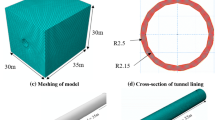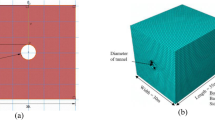Abstract
Underground rock tunnels have been an integral part of human civilization, since several decades. The construction and continuous use of these underground structures have become an essential part of metro cities. Moreover, tunnels and other underground utility construction has an important role as strategic structures, especially in defense sector. Due to these reasons, terrorists and other anti-social activities have targeted tunnels to inflict damage by using explosives that cause blasts. Therefore, tunnels and other underground structures should be design and strengthened against blast loading. In this paper, an attempt has been made to understand the behaviour of three different rock tunnels in commonly found three different rocks i.e., Granite, Basalt and Quartzite. The geometry of the finite element model has been kept constant for each rock type. The nonlinear elastoplastic behaviour has been simulated through Mohr–Coulomb, Johnson–Cook and Concrete-Damage-Plasticity constitutive material models for rock, reinforcement and concrete liners respectively. In addition, the 100 kg of trinitrotoluene (TNT) explosive has been considered throughout the paper for different cases. The advanced method of modelling, i.e., coupled-Eulerian–Lagrangian method has been considered for modelling TNT and air inside the tunnel to simulate internal blast loading. Deformation, shock wave velocity, acceleration, pressure, stress, strain energy and damage are the different parameters extracted, analyzed and discussed in aftermath of internal blast loading effect on rock tunnel. The finite element modelling has been validated through experimental and numerical results presented in the published literature. The finite element software Abaqus has been used for the simulation of internal blast loading in rock tunnel.
































Similar content being viewed by others
Availability of Data and Material
All the data and material used in the present study has been mentioned in the manuscript, no other data has been used.
Code Availability
No separate code/data has been used for the present study.
References
Bangash M, Bangash T (2005) Explosion-resistant buildings: design, analysis, and case studies
Buonsanti M, Leonardi G (2013) 3-D simulation of tunnel structures under blast loading. Arch Civ Mech Eng 13:128–134. https://doi.org/10.1016/j.acme.2012.09.002
Colombo M, Martinelli P, di Prisco M (2016) On the blast resistance of high performance tunnel segments. Mater Struct Constr 49:117–131. https://doi.org/10.1617/s11527-014-0480-7
Gupta AS (1997) Engineering behavior and classification of weathering rock. Indian Institute of Technology Delhi, Delhi
Hafezolghorani M, Hejazi F, Vaghei R et al (2015) Simplified damage plasticity model for concrete. Struct Eng Int. https://doi.org/10.2749/101686616X1081
Han Y, Zhang L, Yang X (2016) Soil—tunnel interaction under medium internal blast loading. Procedia Eng 143:403–410. https://doi.org/10.1016/j.proeng.2016.06.051
Hoffman B, Reinares F (2014) The evolution of the global terrorist threat: from 9/11 to Osama bin Laden’s death
IS456(2000) (2000) Plain and reinforced concrete—code of practice. Parliament of India, New Delhi
Koneshwaran S, Thambiratnam DP, Gallage C (2015) Blast response and failure analysis of a segmented buried tunnel. Struct Eng Int J Int Assoc Bridg Struct Eng 25:419–431. https://doi.org/10.2749/101686615X14355644771054
Larcher M, Casadei F (2010) Explosions in complex geometries—a comparison of several approaches. Int J Prot Struct 1:169–195. https://doi.org/10.1260/2041-4196.1.2.169
Lee J, Fenves G (1998) Plastic damage model for cyclic loading of concrete structures. J Eng Mech 124:892–900
Limited DMRC (2015) Design specifications. Barakhamba road, New Delhi, India
Lubliner J, Oliver J, Oller S, Onate E (1989) A plastic damage model for concrete. Int J Solids Struct 25:299–329
Tiwari R, Chakraborty T, Matsagar V (2016) Dynamic analysis of tunnel in weathered rock subjected to internal blast loading. Rock Mech Rock Eng 49:4441–4458. https://doi.org/10.1007/s00603-016-1043-8
Wu P, Yang T, Jia W (2019) Reliability analysis and prediction on tunnel roof under blasting disturbance. KSCE J Civ Eng 23:4036–4046. https://doi.org/10.1007/s12205-019-1887-z
Yu H, Wang Z, Yuan Y, Li W (2016) Numerical analysis of internal blast effects on underground tunnel in soils. Struct Infrastruct Eng 12:1090–1105. https://doi.org/10.1080/15732479.2015.1077260
Zaid M (2021) Dynamic stability analysis of rock tunnels subjected to impact loading with varying UCS. Geomech Eng 24:505. https://doi.org/10.12989/GAE.2021.24.6.505
Zaid M, Rehan Sadique M (2021) A simple approximate simulation using coupled Eulerian–Lagrangian (CEL) simulation in investigating effects of internal blast in Rock Tunnel. Indian Geotech J. https://doi.org/10.1007/s40098-021-00511-0
Zaid M, Sadique MR (2020a) Effect of Unconfined Compressive Strength of Rock on Dynamic Response of Shallow Unlined Tunnel. SN Appl Sci
Zaid M, Sadique MR (2020b) The response of rock tunnel when subjected to blast loading: Finite element analysis. Eng Reports. https://doi.org/10.1002/eng2.12293
Zaid M, Sadique MR (2020c) Blast resistant behaviour of tunnels in sedimentary rocks. Int J Prot Struct. https://doi.org/10.1177/2041419620951211
Zaid M, Sadique MR (2020d) Numerical modelling of internal blast loading on a rock tunnel. Adv Comput Des 5:417–443. https://doi.org/10.12989/acd.2020.5.4.417
Zaid M, Sadique MR, Alam MM (2021) Blast analysis of tunnels in Manhattan-Schist and Quartz-Schist using coupled-Eulerian–Lagrangian method. Innov Infrastruct Solut. https://doi.org/10.1007/s41062-020-00446-0
Zaid M, Sadique MR, Alam MM, Samanta M (2020) Effect of shear zone on dynamic behaviour of rock tunnel constructed in highly weathered granite. Geomech Eng 23:245. https://doi.org/10.12989/GAE.2020.23.3.245
Zaid M, Shah IA (2021) Numerical analysis of Himalayan rock tunnels under static and blast loading. Geotech Geol Eng. https://doi.org/10.1007/s10706-021-01813-z
Zhao CF, Chen JY (2013) Damage mechanism and mode of square reinforced concrete slab subjected to blast loading. Theor Appl Fract Mech 63–64:54–62. https://doi.org/10.1016/j.tafmec.2013.03.006
Acknowledgements
The authors would like to acknowledge Dr. Azhar Jamil, Assistant Professor, Department of Mechanical Engineering, Aligarh Muslim University, India for providing computational assistance.
Author information
Authors and Affiliations
Contributions
MZ: M. Tech student responsible for carrying out simulation, validation and writing of first draft. MdRS: Main supervisor of M.Tech thesis and responsible for submission of first version of paper. MMA: Co-supervisor of M. Tech thesis and responsible for grammar and other writing corrections.
Corresponding author
Ethics declarations
Conflict of interest
Authors declare that they have no potential conflict of interest.
Additional information
Publisher's Note
Springer Nature remains neutral with regard to jurisdictional claims in published maps and institutional affiliations.
Rights and permissions
About this article
Cite this article
Sadique, M.R., Zaid, M. & Alam, M.M. Rock Tunnel Performance Under Blast Loading Through Finite Element Analysis. Geotech Geol Eng 40, 35–56 (2022). https://doi.org/10.1007/s10706-021-01879-9
Received:
Accepted:
Published:
Issue Date:
DOI: https://doi.org/10.1007/s10706-021-01879-9




